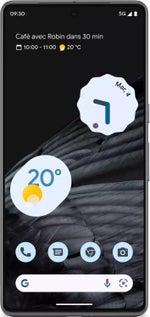Google Pixel 8 and 8 Pro amaze with better cameras, brightest displays, a thermometer!
We may earn a commission if you make a purchase from the links on this page.

After literally months of teasing, Google finally revealed the Pixel 8 and Pixel 8 Pro phones we've all been waiting for to break the Apple-Samsung duopoly in the heart of US phone buyers. Do they have a fighting chance with the new Tensor G3 processor and all the new camera magic that has been added to the feature list? Let's review the Pixel 8 and Pixel 8 Pro price, specs, and design to find out...
Pixel 8 and Pixel 8 Pro design and specs

New Google Pixel 8 and Pixel 8 Pro features
- Upgraded cameras for better low-light photos, selfies, or zoom shots.
- New Magic Editor, Best Take, and Audio Magic Eraser editing options.
- Superbright, up to 2,400 nits Actua displays.
- Faster, more frugal Tensor G3 chipset.
- New, up to 1TB storage options.
- First with Android 14 and 7 years of OS updates!
- Thermometer! (Pixel 8 Pro)
The unique Pixel 8 Pro thermometer feature offers a way to take the temperature of drinks, meals, or foreheads. We asked Google what's the range of the Pixel 8 Pro thermometer and it disclosed the following details:
Object Temperature Sensing will be available in the Thermometer App on Pixel 8 Pro, allowing users to quickly take the temperature of an object by simply scanning it. The sensor works best between -20 C to 150 C (-5F to 302F), and it will support temperatures up to 200C (392F). Object temperatures may vary based on proximity to higher/lower ends of the temperature range, material selection, size of the object, and the difference in temperature between the sensor and the object.
Google Pixel 8 and Pixel 8 Pro prices and launch date
Google kept the price of its 2023 Pixels largely similar, but this time around offers higher storage tiers, up to 1TB for $1399, which shake up the price range of the Pixel 8 and Pixel 8 Pro as follows:
| Google Pixel 8 Pro price | Google Pixel 8 price | |
|---|---|---|
| 128GB | $999 | $699 |
| 256GB | $1059 | $759 |
| 512GB | $1179 | n/a |
| 1TB | $1399 | n/a |
The Google Pixel 8 and Pixel 8 Pro will be available in the US, Canada, Austria, Denmark, France, Germany, Ireland, Italy, Netherlands, Norway, Portugal, Spain, Switzerland, Sweden, UK, Australia, India, Japan, Singapore, and Taiwan on October 11. The Pixel 8 preorder deals include a set of Pixel Buds Pro or a Pixel Watch 2, depending on the region.
Pixel 8 and Pixel 8 Pro design and specs
Brightest screens, new colorways!
The Pixel 8 and 8 Pro take the tried and true approach of a Gorilla Glass Victus-clad body but with Google's unique camera strip twist on the back where you can rest your finger comfortably while using them with one hand. The Pixel 8 is much smaller and lighter than its predecessor, despite that the difference in screen sizes is just a tenth of an inch.
Actua display: the brightest screens on a Pixel
While the 6.2-inch 1080p display with 120Hz refresh rate of the Pixel 8 only shrank by a fraction of an inch, Google's new Actua display line boosts its brightness to 2000 nits, up from the 1400 nits of peak brightness of its predecessor.
The 6.7-inch panel on the Pixel 8 Pro fares even better, as it is a "Super" Actua display with the whopping 2,400 nits of peak brightness making it the brightest Pixel ever and some of the brightest phone display this side of the Oppo Find X6 Pro and its 2,500 nits panel. This one remains an LTPO OLED screen, though, meaning it can offer dynamic 1Hz-120Hz display refresh rate, depending on the content shown to save on battery.
Pixel 8 and Pixel 8 Pro colors
- Bay, Porcelain, and Obsidian (Pixel 8 Pro)
- Hazel, Rose, and Obsidian (Pixel8)
While both phones share an Obsidian colorway, the Pixel 8 Pro comes also in Bay and Porcelain. As usual, Google saved the less somber colors for the Pixel 8, offering it in Hazel and a cute Rose hue. Unlike Samsung, it doesn't offer exclusive colors on its website, so those Pixel 8 and Pixel 8 Pro colors can be had anywhere it's available to buy.
Pixel 8 and Pixel 8 Pro camera
The handsets come with upgraded camera sensors, sharing a 50MP 50 MP Octa PD wide camera with 1/1.31" image sensor, 1.2 μm pixel size, and generous ƒ/1.68 aperture. They differ in the ultrawide camera section, though, as the the Pixel 8 Pro has four times the resolution count of the 12MP sensor on the Pixel 8 and can offer more detailed wide-angle images.
The exclusive camera value that the Pixel 8 Pro brings to the table is again a 5x optical periscope zoom kit with 48MP sensor underneath. It's not the 50MP one on the Oppo Find X6 Pro but it is still one of the most capable phone zoom cameras, while rumor has it that the Galaxy S24 Ultra will take the same large-sensor folded zoom optics approach.
New Pixel 8 and Pixel 8 Pro camera features
- Upgraded pro-level cameras for better low-light photos, sharper selfies, and zoom photos or videos.
- Video Boost technology brings HDR+ and enhanced color grading for professional-looking videos, plus first Night Sight Video (coming at a later date).
- Pro controls with advanced camera settings and high-resolution photography.
- New Magic Editor, Best Take, and Audio Magic Eraser editing options.


Tensor G3 processor and storage

- Higher clock count for more powerful peak performance.
- 15% faster deca-core ARM Mali-715 graphics
- 10% faster AI TPU
- Lower power consumption
The new Google Tensor 3 chipset that powers the Pixel 8 series is, of course, faster than the G2 with its 1x Cortex X3 + 4x Cortex-A715 + 4x Cortex A-510 configuration clocked as follows:
| Tensor G3 | Tensor G2 | Tensor G1 |
|---|---|---|
| 1x Cortex-X3 @ 3.0GHz | 2x Cortex-X1 @ 2.85GHz | 2x Cortex-X1 @ 2.8GHz |
| 4x Cortex-A715 @ 2.45GHz | 2x Cortex-A78 @ 2.3GHz | 2x Cortex-A76 @ 2.25GHz |
| 4x Cortex-A510 @ 2.15GHz | 4x Cortex-A55 @ 1.8GHz | 4x Cortex-A55 @ 1.8GHz |
That's not the only story, though. The Tensor G3 is Google's first 64 bit-only chipset, just like the Snapdragon 8 Gen 3 is expected to be for Qualcomm. As for graphics, a 15% faster Mali-G715 GPU is on the block, plus a new custom "Rio" TPU that is more powerful than the 1GHz "Janerio" on Tensor G2.
While not on the Snapdragon 8 Gen 3 level of performance, the Google Tensor G3 should match and even surpass the excellent Snapdragon 8 Gen 2 that all major 2023 Android flagships are now powered by.
The 10 generic graphics cores clocked at 890 Hz are unlikely to beat graphics performance records and elevate the Tensor G3 to the rendering level of the Snapdragon 8 Gen 3, Apple A17, or MediaTek Dimensity 9200 but they would be a decent upgrade over the admittedly underpowered graphics of its predecessor that lagged behind in our benchmark tests.
Battery life and charging
With a 4,500 mAh battery on the Pixel 8 and a 5,000 mAh one on the Pixel 8 Pro, Google is unlikely to win any battery life competitions considering that the ultrabright Actua displays would more than offset any power draw gains from the Tensor G3. They should offer comfortable "beyond 24-hour battery life," though, just as Google promises. Unfortunately, the charging speeds is still 30W for both phones, so only expect bringing of the battery to 50% capacity in about half an hour, and that's that, while for the same time the Chinese competitors can bring it to full charge now.
In a nutshell, Google managed to set the Pixel 8 and Pixel 8 Pro apart from the competition yet again, and not only with the cool (or hot) thermometer feature, but with upgrades to their already excellent camera kits and image processing power, plus new storage tiers and flashy colors. Any takers?


















Things that are NOT allowed: